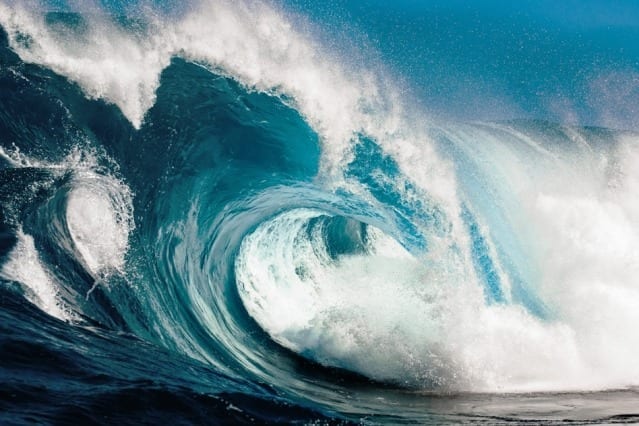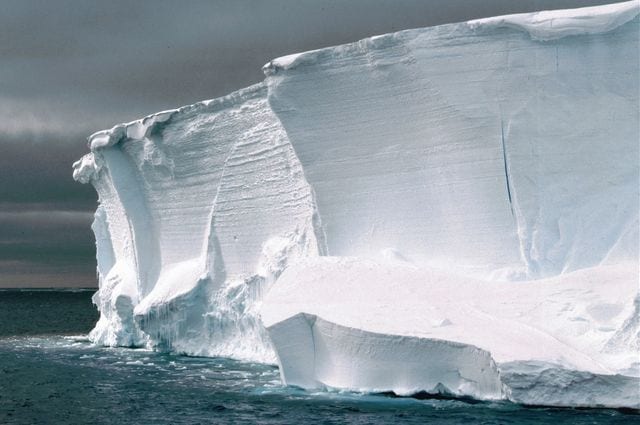
Image: MIT News
Rogue wave ahead
Sailing history is rife with tales of monster-sized rogue waves — huge, towering walls of water that seemingly rise up from nothing to dwarf, then deluge, vessel and crew. Rogue waves can measure eight times higher than the surrounding seas and can strike in otherwise calm waters, with virtually no warning.
Now a prediction tool developed by MIT engineers may give sailors a 2-3 minute warning of an incoming rogue wave, providing them with enough time to shut down essential operations on a ship or offshore platform.
The tool, in the form of an algorithm, sifts through data from surrounding waves to spot clusters of waves that may develop into a rogue wave. Depending on a wave group’s length and height, the algorithm computes a probability that the group will turn into a rogue wave within the next few minutes.
“It’s precise in the sense that it’s telling us very accurately the location and the time that this rare event will happen,” says Themis Sapsis, the American Bureau of Shipping Career Development Assistant Professor of Mechanical Engineering at MIT. “We have a range of possibilities, and we can say that this will be a dangerous wave, and you’d better do something. That’s really all you need.”
“Not just bad luck”
Like many complex systems, the open ocean can be represented as a chaotic mix of constantly changing data points. To understand and predict rare events such as rogue waves, scientists have typically taken a leave-no-wave-behind approach, in which they try to simulate every individual wave in a given body of water, to give a high-resolution picture of the sea state, as well as any suspicious, rogue-like activity. This extremely detailed approach is also computationally expensive, as it requires a cluster of computers to solve equations for each and every wave, and their interactions with surrounding waves.
“It’s accurate, but it’s extremely slow — you cannot run these computations on your laptop,” Sapsis says. “There’s no way to predict rogue waves practically. That’s the gap we’re trying to address.”
Sapsis and Cousins devised a much simpler, faster way to predict rogue waves, given data on the surrounding wave field.
In previous work, the team identified one mechanism by which rogue waves form in unidirectional wave fields. They observed that, while the open ocean consists of many waves, most of which move independently of each other, some waves cluster together in a single wave group, rolling through the ocean together. Certain wave groups, they found, end up “focusing” or exchanging energy in a way that eventually leads to an extreme rogue wave.
“These waves really talk to each other,” Sapsis says. “They interact and exchange energy. It’s not just bad luck. It’s the dynamics that create this phenomenon.”
Learn more: New prediction tool gives 2-3 minute warning of incoming rogue waves
The Latest on: Predicting rogue waves
[google_news title=”” keyword=”predicting rogue waves” num_posts=”10″ blurb_length=”0″ show_thumb=”left”]
via Google News
The Latest on: Predicting rogue waves
- Huk Rogue Wave: The Ultimate Fishing Booton April 25, 2024 at 8:00 am
We tested the Huk Rogue Wave boots in every condition possible, from saltwater fishing and boating to turkey hunting. Here's our review on how the shoe performed.
- Why is it so cold in the UK right now and when is it going to get warmer?on April 24, 2024 at 8:31 am
Even though we’re now deep into springtime, many Brits have still found themselves holding onto their winter coats as cold spells have swept across the country in recent weeks.
- Rogue waves are more common than we thought – and could get worseon April 22, 2024 at 4:29 am
Long thought to be a myth imagined by sailors, these killers have now been seen and studied in real life. They are rogue waves. Rearing out of the sea up to 30 metres high – taller than three London ...
- Google builds an AI model that can predict future weather catastropheson April 22, 2024 at 3:00 am
A new system uses generative AI to predict weather faster and more cheaply than ever — while detecting difficult-to-spot extreme weather events — beating the world's major weather agencies.
- Rogue Waves In The Ocean Are Much More Common Than Anyone Suspected, Says New Studyon April 21, 2024 at 10:44 am
Under consistent ocean conditions, rogue waves generated this way may occur once every two days at a set location. But the ocean is dynamic, so conditions are rarely consistent for long – making it ...
- The Prevalence of Giant Rogue Waves: New Studies Indicate More Frequent Occurrenceson April 21, 2024 at 4:51 am
Recent research using three-dimensional imaging of ocean waves has uncovered astonishing insights about rogue waves, and these findings have been published in the esteemed journal, Physical Review ...
- Rogue Waves: New Tech Captured This Elusive, Freakish Phenomenon In Ocean Waveson April 21, 2024 at 3:00 am
Rogue waves are giant colossi of the sea — twice as high as neighboring waves — that appear seemingly out of nowhere. Stories of unimaginable mountains of water as tall as ten-storey buildings have ...
- Royal Expert’s Prediction for Prince Louis’ Future Feels Awfully Sexist & Now We Have the Ickon April 18, 2024 at 9:16 am
There’s been a lot of talk lately — and frankly, there probably always will be — about what the “spares” in the Wales family will do in the future. And how, if possible, does the royal family keep ...
- The Cause of Giant Rogue Waves is Revealedon April 17, 2024 at 11:55 am
Giant rogue waves a far higher than other waves around it, and they often seem to come out of nowhere to wreak havoc on ships and shorelines. | Earth And The Environment ...
- Africa: Rogue Waves in the Ocean Are Much More Common Than Anyone Suspected, Says New Studyon April 16, 2024 at 11:10 am
Analysis - We used three-dimensional imaging of ocean waves to capture freakish seas that produce a notorious phenomenon known as rogue waves. Our results are now published in Physical Review Letters* ...
via Bing News









